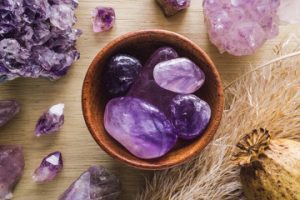Amethyst Crystals – Meaning, Properties & Benefits
Amethyst crystals have been used for thousands of years and are one of the world’s most popular gemstones. The stone is thought to have healing properties that date back to ancient Greek beliefs. The term “amethyst” is derived from the Greek word “amethystos,” which means “sober,” and refers to the idea of maintaining a solid, sober mindset.
If you’ve always wanted to learn more about amethyst or love purple gemstones, now’s your chance. We’ve compiled everything you need to know about this regal gem, from its meaning to its healing properties.
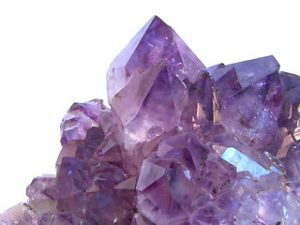
What Exactly Is Amethyst?
Amethyst crystals form in geodes or hollow rocks as long, prismatic crystals. These geodes form when cavities are in volcanic rock formations. Mineral-saturated water, gases, and volcanic material distill and crystallize as the rock cools. Amethyst is formed when these crystals harden. Although the stone is generally a deeper purple, it can also have a reddish glow or a very slight purple tinge that fades into lilac.
Natural amethyst has been worn for at least 2000 years, while synthetic amethyst is much newer and less common. Amethyst, a member of the quartz family distinguished by its distinctive purple color, has a Mohs hardness of seven. Amethyst gems are extremely durable, making them ideal for all types of jewelry. Amethyst is frequently used in earrings, pendants, bracelets, and rings, and it is also cut to make bracelet cuffs or beads. ac.
Because of its hardness and durability, the stone can be cut into a variety of shapes, increasing its versatility. Faceted pieces, beds, and cabochons are some of the more popular cuts. Natural amethyst of high quality can be found in Sri Lanka, Siberia, Brazil, Uruguay, Namibia, and the Far East, as well as large deposits in Namibia, Australia, and America. South America has the largest cache of this gem.
The price of an amethyst stone is determined by several factors, including the size of the stone and the depth of its color.
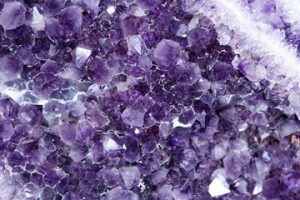
Amethyst Varieties
Amethyst comes in several varieties, each with a distinct purple to reddish-purple hues. Lavender amethyst, a lighter color, and Canadian amethyst are two gem varieties. The latter has a red layer just beneath its surface, which increases the vibrancy of the color. Ametrine, cactus quartz, and Veracruz amethyst are some other types of amethyst.
Amethyst stones, whether synthetic or natural, are breathtakingly beautiful. The stone’s gorgeous purple color can complement any outfit and can be set in almost any metal. Aside from these colors, amethyst also comes in blue, chevron, and pink.
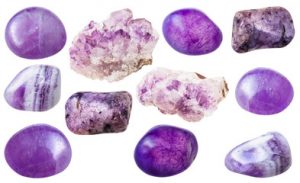
Amethyst synthetic
Synthetic amethyst comes in the same purple and reddish-purple hues as natural amethyst. However, synthetic amethyst is significantly less expensive and can be produced quickly. This lab-created stone has been around for nearly two decades and has significantly lowered the market prices of its natural counterparts.
Synthetic amethyst has become relatively simple to produce over the last two decades. These stones are so well made and similar to natural amethyst that even gemologists have difficulty distinguishing between synthetic and genuine. Because synthetic tones are so durable, they are used in almost every type of jewelry.
Amethyst Meaning & Symbolism
The third eye and crown chakras are associated with natural amethyst stones. Amethyst’s purple to reddish-purple hues has long been associated with peace, cleansing, and calming energy.
Purification and connection to spiritual and divine beings are represented by the crystals. Amethyst is associated with serenity, understanding, trust, and grace. This gem has spiritual overtones in many cultures.
Healing Properties of Amethyst
Amethyst is thought to have healing properties that shield the wearer from negative energies. Some believe that the stone’s calming properties produce peaceful dreams by bringing us closer to the divine. The stone also helps the mind flow freely in both the mental and metaphysical dimensions, bringing clarity and peace to the waking mind.
It was once thought that natural amethyst could cleanse the body of all toxins. The ancient Greeks believed that the stone protected the wearer from intoxication and allowed them to maintain a balanced mindset. To prevent inebriation, wine was sipped from goblets containing amethyst stones, and stones were laid on the sick to draw out infection.
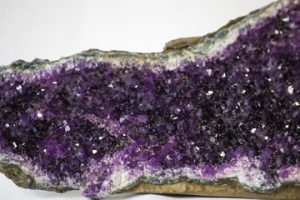
What Are the Advantages of Amethyst?
Aside from its physical properties and benefits, amethyst’s purple color is a natural tranquilizer. It is said to calm rage and anxiety, dispel rage and help manage fears and anger.
Amethyst is also thought to have the ability to alleviate sadness and grief, as well as dissolve negativity. This gem’s color is also associated with awakening spiritual awareness, welcoming intuitive energies, and enhancing psychic abilities.
What Is the Spiritual Meaning of Amethyst?
Amethyst is highly valued in spiritual circles. It can control evil thoughts, initiate wisdom, and boost intelligence by increasing understanding. The stone can help you apply your intellectual abilities in difficult situations and think more clearly to make better decisions.
This purple gem is also thought to enhance intuition and have wonderful, positive effects on creativity and imaginative powers. It enables its bearers to embrace new ideas and put them into action.
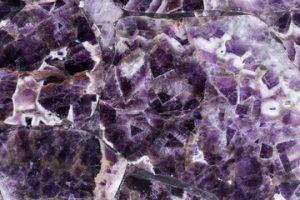
What are the negative effects of amethyst stone?
Natural amethyst stones are said to have negative effects on occasion, but these are uncommon. Acne, dizziness, nausea, breast pain, water retention, and abdominal bloating are just a few of the side effects.
Although uncommon, amethyst can have serious side effects. Migraines, abdominal pain, and dermatological reactions such as a rough patch of skin or a slight rash are possible.
Do Amethysts Fade Over Time?
The amethyst color will fade if left in the sun for too long or exposed to any source of UV for an extended period. Furthermore, if the stone is exposed to heat for an extended period, the purple color is likely to fade.
With proper care and cleaning, your amethyst crystal will last for a long time. The color is unlikely to fade if properly protected from harsh elements such as prolonged exposure to water or sunlight.
Is Amethyst Transparent?
In general, amethyst is ‘eye-clean,’ which refers to a stone that is free of visible inclusions to the naked eye. Authentic amethyst stones are likely to be quite clear in appearance, making it easy to determine whether the stone is genuine or synthetic.
